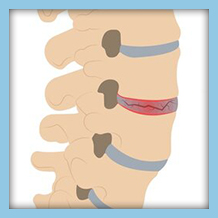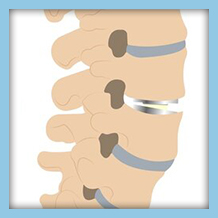

There’s a difference between lifestyle-based back pain and persistent, unexplained back pain. If you’re contending with the latter, there’s a chance that the discs supporting your lumbar vertebrae may be damaged. You can consult with orthopedic spine surgeons to determine whether or not lumbar disc replacement surgery or artificial disc replacement surgery has a place in your future.
Signs You May Need Lumbar Disc Replacement Surgery
There’s a difference between temporary lower back pain and persistent, life-altering conditions. If you’ve previously sought out lower back pain treatment and failed to find a means to relieve your condition, it may be time to consider lumbar disc replacement surgery. Medical professionals can use in-house tools to identify which diseased disc is causing your pain and how it may be impacting your spinal nerves. That said, all kinds of people can fall victim to lumbar pain. Medical professionals may recommend other forms of back pain treatment if you:
- Have a history of joint disease
- Have wider-spread back pain
- Have previously benefited from a spinal surgery
- Contend with scoliosis or spinal injuries
- Are overweight
You can talk about how these conditions may impact the health of your back during an appointment with our team.
Preparing for Lumbar Disk Replacement Surgery
Before you commit to lumbar disk replacement surgery, preparing your home for recovery is in your best interest. Lumbar disk replacement surgery requires a few weeks of recovery, during which you’ll need to engage in low-stress movement. With that in mind, you can work with your loved ones to fit your house for adequate rest and recovery.
Toilet risers and object grabbers come in handy when trying to reduce the strain on your lower back. You may also want to work with loved ones to pre-prepare meals to eat during your recovery.
Before your surgery, medical professionals may recommend you stop smoking or try to lose weight. These efforts can improve your overall health and may prevent the pain in your lower back from returning.
What is Lumbar Disc Replacement?
An lumbar artificial disk replacement is a type of spine or back surgery. You have bones in your spine that are called vertebrae that are stacked up on one another. The discs between your vertebrae act like cushions, allowing your vertebrae to move and rotate without your bones rubbing up against one another. Your lumbar vertebra and discs are located at the bottom of your spine. Through the lumbar disc replacement procedure, the surgeon replaces a degenerated or worn disc in your lower spine with an artificial disc made of metal or combines plastic and metal.
Surgeons often use lumbar disc replacement as an alternative to spinal fusion surgery. Fusion joins two vertebrae together permanently. Lumbar disc replacement is considered major surgery. Therefore it requires a hospital stay and general anesthesia.
Are you a Good Candidate for Lumbar Disc Replacement
The primary reason you’d require this procedure is to treat low back pain. Even so, not all people with lower back pain are good candidates for lumbar disc replacement. Your doctor will conduct specific tests first to determine if you’re a good candidate for the procedure.
While lumbar fusion is a common treatment for chronic low back pain, it does not preserve spinal movement like lumbar disc replacement does. It is important to consult with a spine surgeon who is experienced in both procedures to explore your options.
Generally, this procedure may be recommended if:
- You’re experiencing back pain that comes mainly from only one or two discs in your lower spine
- You’re not excessively overweight
- You don’t have any substantial compression or joint disease on the nerves of your spine
- You don’t have a spinal deformity like scoliosis
- You haven’t already had spinal surgery in the past
Of course, you’ll sit with your spine surgeon and discuss all your options, including lumbar disk replacement surgery. They’ll review the benefits and any potential risks associated with the procedure.
Benefits of Lumbar Disc Replacement Surgery
Lumbar total disc replacement has been highly influential in decreasing pain in individuals struggling with degenerative disc disease. Since the surgeon removes the diseased intervertebral disc, nerve roots and nerves are no longer pinched. Bone spurs are smoothed, so they no longer rub against any sensitive structures. The surgeon restores the average distance between the bones of the spine. These combined interventions help provide chronic low back pain relief.
An outstanding additional benefit of this surgery is it helps preserve and restore motion in your spine. Both artificial disc replacement and spinal fusion — the two surgical procedures for treating degenerative disc disease — help alleviate back pain. But, only lumbar disc replacement preserves your lumbar spine’s ability to:
- Flex
- Bend
- Rotate
The new artificial disc acts in various ways similar to a healthy, natural disc, instead of your two spinal bones being fused in spinal fusion surgery.
Following a lumbar disc replacement surgery, individuals can typically return to many of their once-enjoyed activities. But, with spinal fusion, there’s a more limited spinal range of motion, so this also limits the individual’s ability to move their spine normally. Total disc replacement offers a minimally invasive alternative that preserves natural motion and enhances the quality of life for patients.
Potential Lumbar Disc Replacement Risks
Overall, lumbar artificial disc replacement has a low risk of severe complications. However, all surgeries carry some risks:
- Bleeding
- Infection
- Nerve damage
- A reaction to general anesthesia
Also, although rare, the artificial disc could move out of its intended position. A second procedure would be required to reposition the implant if this occurs.
While individuals once had concerns about artificial discs wearing out, today, the more modern artificial lumbar discs last a lot longer (for decades) without causing problems or wearing out. And when this procedure is performed by a highly-skilled and experienced spine surgeon, the risks linked with lumbar disc replacement are much lower.
What to Expect From Lumbar Disc Replacement Surgery
Some medical professionals consider lumbar disc replacement surgery, also known as lumbar artificial disc replacement, the less invasive alternative to spinal fusion surgery. This process sees medical professionals replace a worn-out disc near the lower part of your back with an alternative material meant to preserve your posture, reduce your pain, and protect your vertebrae from harm.
This surgery requires anesthesia. You may have to remain in the hospital for a day or two if medical professionals have concerns about your recovery. Before medical professionals recommend this treatment, however, they may schedule you for an MRI and blood tests.
These processes are designed to help medical professionals pinpoint the source of your pain. If you’re still contending with severe spinal pain after using over-the-counter medications, you can discuss the benefits of this treatment.
Plan Your Recovery Ahead of Time
As mentioned, medical professionals may request that you remain in the hospital for one or two days after your surgery. After your release, you should expect to spend some time participating in physical therapy exercises. The more flexible you stay, the faster you’re likely to recover.
That said, you should avoid any behaviors that strain your lower spine. You’ll need to frequently stand and stretch if you work a job that sees you sitting for several hours a day. So long as you don’t overdo your exercises, you should be back on your feet in a matter of weeks.
Make sure, too, that you discuss what pain levels to expect in your back with an attending medical professional. While lumbar disc replacement surgeries can reduce the amount of lumbar pain you endure, they may not rid you of this pain entirely. Depending on your condition, you may still benefit from over-the-counter painkillers or future treatments.
Let’s Discuss Your Lumbar Disc Replacement Needs Today
Lumbar disc replacement surgeries help you combat severe lower back pain and disc deformation. That said, the process isn’t for everyone. At Orthopedic & Laser Spine Surgery, we strive to provide individualized treatment programs for each patient. When you come to our team, we’ll perform non-invasive diagnostics to understand your condition better.
If you have questions about the services we make available to our patients, you can contact us today. We can work with you to discuss which of our treatments may help you relieve the pain in your back. Schedule an appointment through our contact form or by calling (855)-853-6542.
Q&A
What is lumbar spine surgery, and when is it necessary?
Lumbar surgery is often required when a disc in the lower spine causes severe pain or impacts nerve function. If non-surgical treatments fail, procedures like lumbar disc replacement surgery or spinal fusion may be recommended to alleviate the pain and restore mobility.
How does an artificial disc help in lumbar spine surgery?
During lumbar disc replacement surgery, a surgeon replaces a diseased disc in the lower spine with an artificial disc. This disc acts as a cushion between vertebrae, preserving motion and reducing pain, unlike spinal fusion, which limits mobility by fusing bones together.
What role does physical therapy play after lumbar disc replacement surgery?
After lumbar spine surgery, especially disc replacement surgery, physical therapy is crucial for recovery. It helps restore flexibility, strengthen muscles, and promote healing, allowing patients to regain normal movement and return to daily activities more quickly.
Are there risks involved with lumbar disc replacement surgery?
Like any surgery, lumbar disc replacement carries some risks, including infection, nerve damage, or the artificial disc shifting out of place. However, modern artificial discs are durable, and when performed by an experienced spine surgeon, the risks are significantly reduced.
How can lumbar disc replacement surgery improve the quality of life for patients with a diseased disc?
Lumbar disc replacement surgery can significantly reduce chronic pain caused by a diseased disc. Unlike spinal fusion, artificial disc replacement preserves the natural movement of the spine, allowing patients to enjoy greater flexibility and a faster return to their usual activities.
